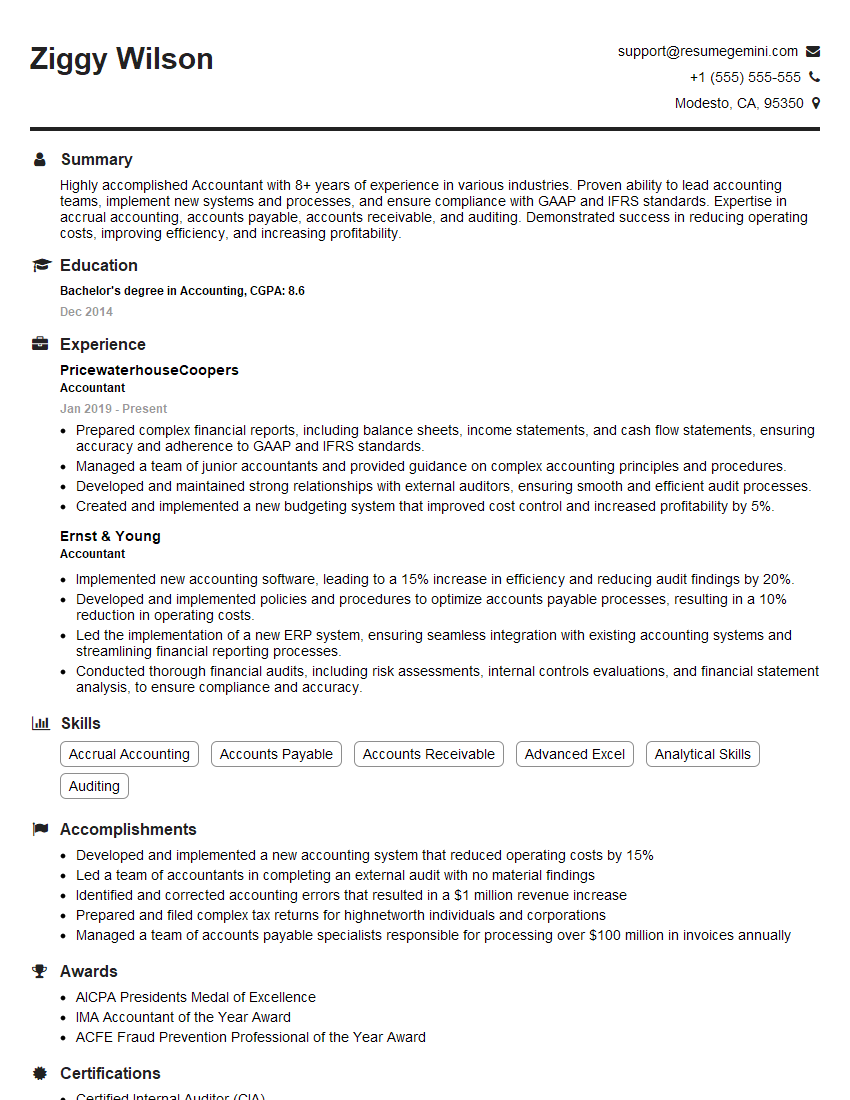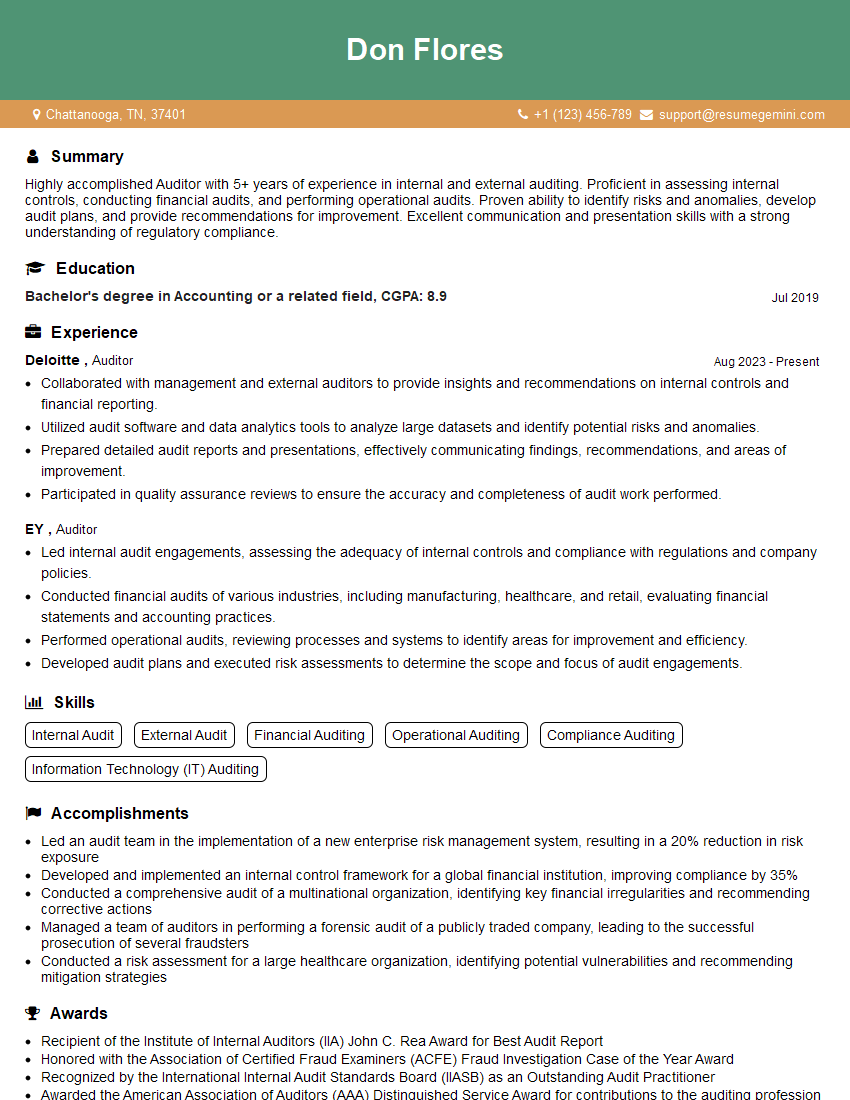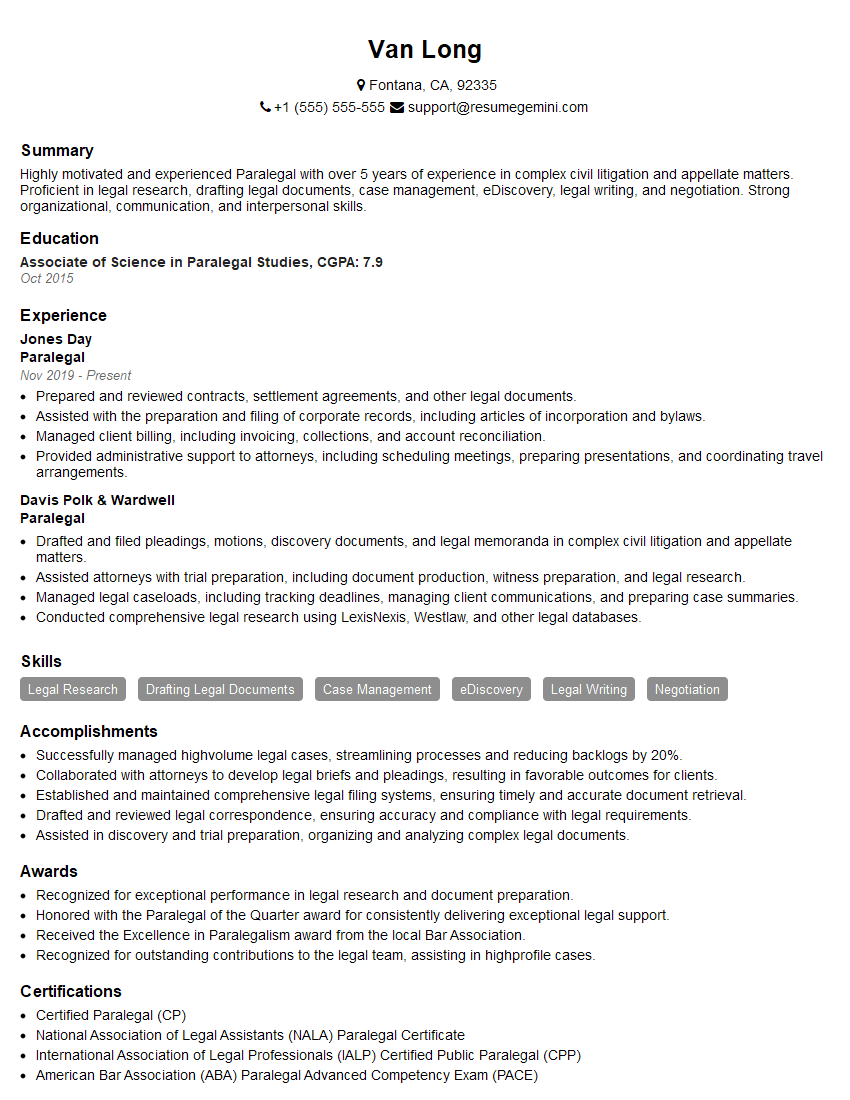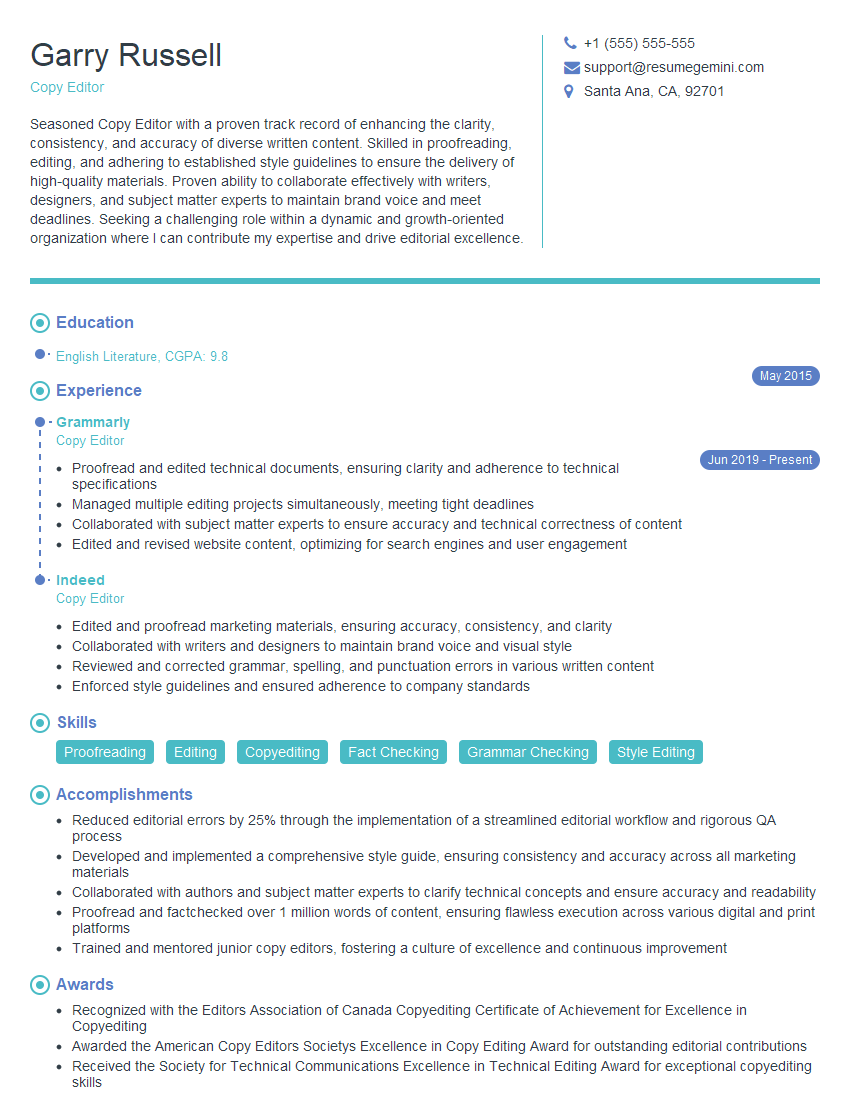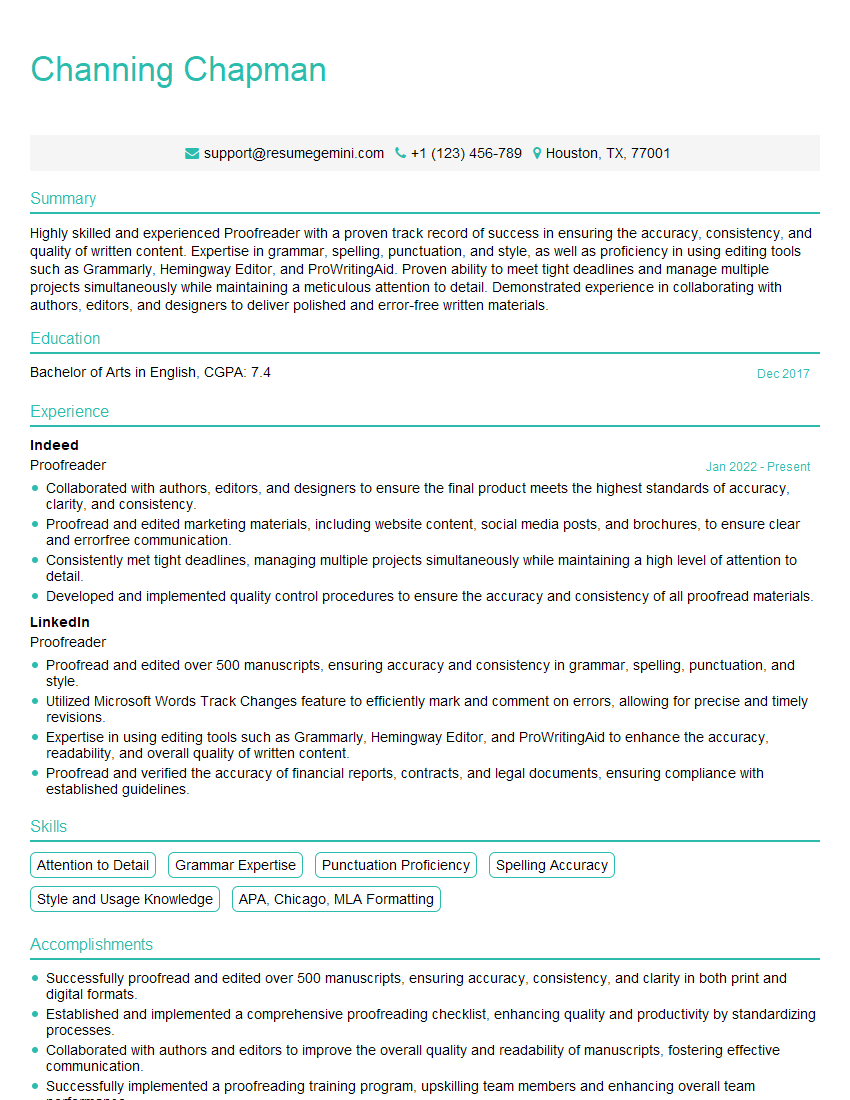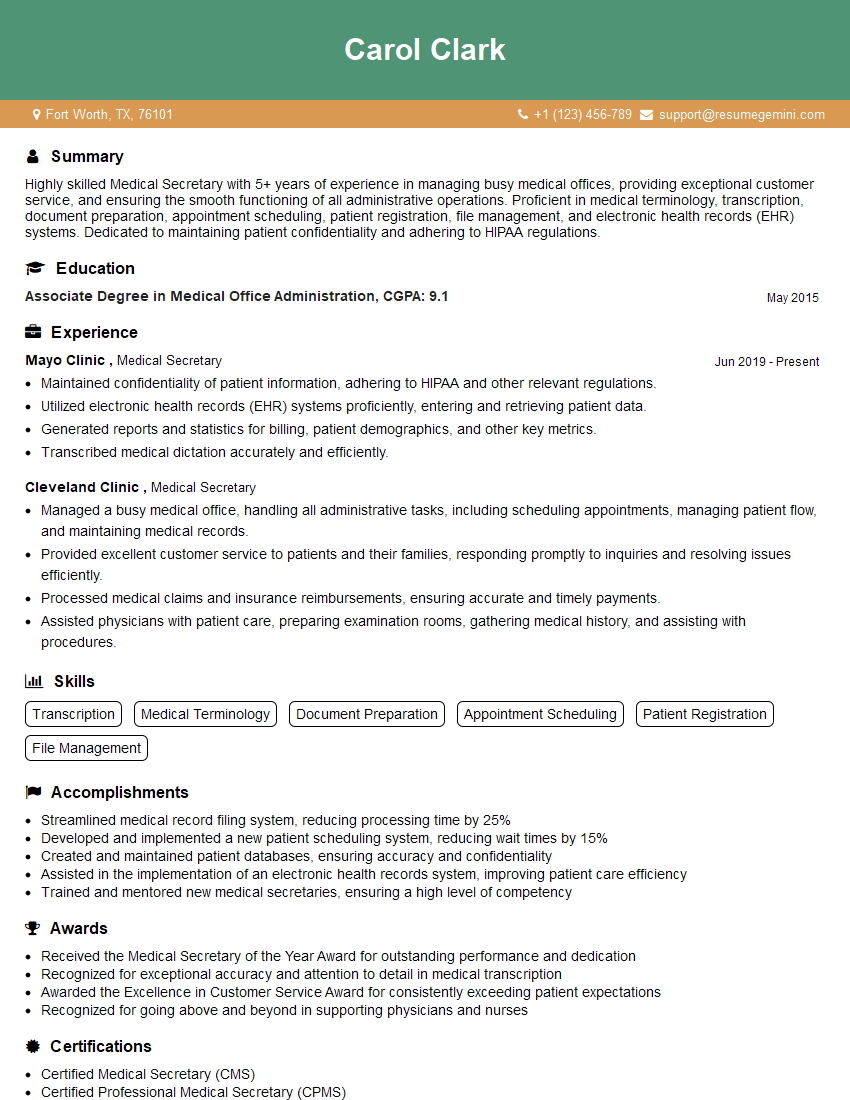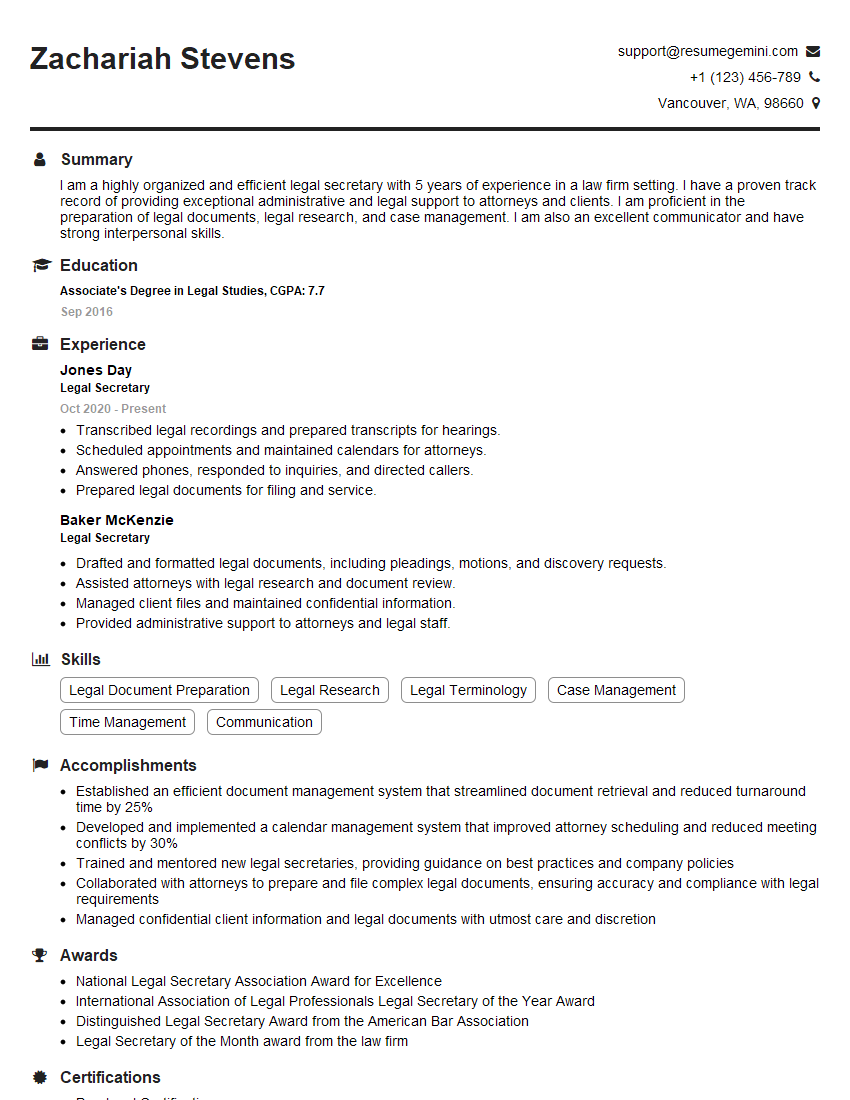Cracking a skill-specific interview, like one for Time Management and Attention to Detail, requires understanding the nuances of the role. In this blog, we present the questions you’re most likely to encounter, along with insights into how to answer them effectively. Let’s ensure you’re ready to make a strong impression.
Questions Asked in Time Management and Attention to Detail Interview
Q 1. Describe your approach to prioritizing tasks when facing competing deadlines.
Prioritizing tasks with competing deadlines requires a strategic approach. I utilize a combination of methods, starting with a clear understanding of each task’s urgency and importance. I employ the Eisenhower Matrix (Urgent/Important), categorizing tasks into four quadrants: Do, Decide, Delegate, and Delete. This helps me focus on high-impact, time-sensitive tasks first. For example, if I have a crucial presentation due tomorrow and a less urgent report due next week, the presentation takes priority. I then break down larger tasks into smaller, more manageable chunks, assigning realistic deadlines to each. This allows for better tracking of progress and prevents feeling overwhelmed. Finally, I regularly review and adjust my priorities as new information or unexpected events arise, ensuring flexibility and adaptability.
Q 2. How do you ensure accuracy in your work, especially under pressure?
Accuracy under pressure is paramount. My approach involves a multi-layered strategy. First, I meticulously plan my work, ensuring a clear understanding of requirements and potential pitfalls. I create detailed checklists and use templates to standardize processes and minimize errors. Second, I incorporate regular self-checks and peer reviews throughout the process. This allows for early identification and correction of inaccuracies. Third, I understand that perfectionism can be counterproductive under pressure. I aim for ‘good enough’ first, focusing on the most critical aspects, then refining as time allows. For instance, if I’m working on a complex spreadsheet, I’ll first ensure the core calculations are correct before focusing on formatting or minor details. Finally, I always double-check my work before submission, using tools like spell checkers and proofreading software to catch any missed errors.
Q 3. Explain your method for managing multiple projects simultaneously.
Managing multiple projects effectively requires a robust organizational system. I utilize project management tools like Trello or Asana to visually track tasks across different projects. Each project has its own board with clearly defined stages and deadlines. I allocate specific time blocks for each project, preventing multitasking and maximizing focus. For instance, I might dedicate Monday mornings to Project A, Tuesday afternoons to Project B, and so on. Regular project reviews, ideally weekly, help me identify potential bottlenecks or schedule conflicts, allowing proactive adjustments. Communication is key – I maintain open lines of communication with stakeholders to ensure alignment and address any emerging issues promptly. This structured approach ensures efficient resource allocation and prevents project overlap.
Q 4. How do you handle interruptions that disrupt your workflow?
Interruptions are inevitable, but their impact can be minimized. I employ several strategies. First, I communicate my availability to colleagues, setting specific times for focused work and meetings. Second, I utilize techniques like the Pomodoro Technique (25 minutes of focused work followed by a 5-minute break), creating short bursts of intense concentration. Third, I batch similar tasks together. For example, I’ll answer all emails at designated times instead of reacting to each one individually. This minimizes context switching and improves focus. If an urgent interruption arises, I quickly assess its priority and decide whether to address it immediately or postpone it until after my current task. By planning for interruptions and establishing clear boundaries, I can maintain productivity and minimize workflow disruptions.
Q 5. What strategies do you use to stay organized and avoid overlooking details?
Staying organized and avoiding overlooked details is crucial. I utilize a multi-pronged approach. I maintain a detailed digital calendar for appointments and deadlines. I employ task management software to track projects and sub-tasks, leveraging features like checklists and sub-tasks for granular detail. Furthermore, I maintain a clean and organized physical workspace, ensuring easy access to necessary documents and materials. Regular file backups and cloud storage ensure data security and accessibility. I also employ a color-coded filing system both digitally and physically. Finally, I regularly review my work, cross-referencing information and ensuring consistency across all documents. This layered approach minimizes the risk of overlooking even minor details.
Q 6. Describe a time you had to meet a tight deadline. What steps did you take?
I once had to deliver a critical report to a major client within 24 hours. This required immediate and decisive action. First, I prioritized the most essential sections of the report, focusing on core data and analysis. Second, I delegated less critical tasks where possible to team members. Third, I worked extended hours, utilizing short breaks to maintain focus. Fourth, I employed a rapid prototyping approach, creating a basic version quickly, then iteratively refining it with feedback. Fifth, I communicated regularly with the client to manage expectations. By prioritizing, delegating, and maintaining clear communication, I successfully delivered the report on time and met client expectations.
Q 7. How do you use technology to improve your time management?
Technology is a critical component of my time management strategy. I utilize calendar apps (Google Calendar, Outlook Calendar) for scheduling and reminders. Task management software (Trello, Asana, Todoist) helps me track projects and deadlines, while note-taking apps (Evernote, OneNote) assist with capturing and organizing ideas. I use time-tracking tools (Toggl Track, RescueTime) to understand my work patterns and identify areas for improvement. Automation tools (Zapier, IFTTT) automate repetitive tasks, freeing up time for more important activities. These tools not only improve efficiency but also provide valuable insights into my workflow, allowing for continuous optimization.
Q 8. How do you identify and correct errors in your work?
Identifying and correcting errors is a crucial aspect of my work process. I employ a multi-layered approach, starting with proactive measures to minimize errors before they occur. Then, I use a systematic process to identify and rectify any that do slip through.
Proactive Measures: This includes thorough planning, double-checking my work, using checklists, and seeking feedback before finalizing anything. Think of it like building a house – you wouldn’t skip laying a solid foundation!
Error Detection: Once completed, I review my work meticulously, often using a different method than the one used to create it. For instance, if I created a spreadsheet, I might print it out and manually check the calculations. I also utilize tools like spell checkers, grammar checkers, and software-specific validation functions.
Corrective Actions: Once errors are identified, I document them carefully, understanding the root cause. Simply fixing the error isn’t enough; I analyze why it happened to prevent recurrence. This might involve improving my processes, seeking additional training, or refining my tools. This is akin to a doctor diagnosing a patient, not just treating the symptoms.
For example, during a recent project involving data entry, I noticed an inconsistency in formatting. Instead of just correcting the formatting, I investigated the source of the inconsistency, discovering a flaw in the data import process. I then implemented a solution to prevent similar errors in future imports.
Q 9. How do you delegate tasks effectively to maximize efficiency?
Effective delegation is about more than just assigning tasks; it’s about empowering team members to succeed. My approach centers on selecting the right person for the job, providing clear instructions, and offering ongoing support.
Assess Skills and Capacity: I carefully consider each team member’s strengths, experience, and current workload before delegating. This ensures tasks are matched to individual capabilities and prevents overload.
Provide Clear Instructions: Ambiguity is the enemy of efficiency. I provide clear, concise instructions, including deadlines, expected outcomes, and any relevant resources or guidelines. I ensure understanding by encouraging questions and confirming comprehension.
Empower and Support: I avoid micromanagement, trusting team members to perform their tasks. However, I remain available for guidance and support throughout the process. Regular check-ins help monitor progress and address any challenges promptly.
Feedback and Recognition: Providing constructive feedback and recognizing accomplishments is critical for motivation and improvement. This fosters a positive and productive work environment.
For instance, in a past project, I delegated data analysis to a junior team member who possessed strong analytical skills but lacked experience in a specific software. I provided training on the software, assigned smaller, manageable tasks initially, and offered regular support. This allowed the team member to gain valuable experience while contributing effectively to the project.
Q 10. What is your preferred method for tracking your progress on projects?
I utilize a combination of methods to track my project progress, selecting the most suitable approach depending on the project’s complexity and timeline.
Project Management Software: For larger, more complex projects, I rely on project management software like Asana or Trello. These tools allow for task assignment, progress tracking, deadline setting, and collaboration with team members. They provide a visual overview of the project’s status.
Spreadsheets: For smaller projects or individual tasks, a simple spreadsheet can be highly effective. I create a spreadsheet listing tasks, deadlines, progress status (e.g., completed, in progress, pending), and any relevant notes.
Kanban Boards: A visual Kanban board, either physical or digital, helps to visualize workflow and identify bottlenecks. Tasks are moved across columns representing different stages of completion (e.g., To Do, In Progress, Done).
Regular Check-ins and Reporting: Regardless of the chosen method, I schedule regular check-ins with myself and/or my team to review progress, identify potential issues, and adjust the plan as needed. Progress reports provide a structured summary of accomplishments and challenges.
The key is consistency and choosing a method that fits the project and my working style.
Q 11. Describe a situation where attention to detail prevented a problem.
In a previous role, I was responsible for reviewing financial reports before submission. During one review, I noticed a small discrepancy – a misplaced decimal point in a large sum. This seemingly minor detail could have resulted in a significant financial error if overlooked. My attention to detail prevented a potentially serious problem, saving the company from substantial losses and maintaining the accuracy of our financial reporting.
Q 12. How do you handle unexpected changes or delays in your schedule?
Unexpected changes and delays are inevitable in any project. My approach involves a combination of flexibility, proactive planning, and effective communication.
Re-evaluation and Prioritization: Upon encountering a change or delay, I assess its impact on the overall project. I then re-prioritize tasks based on their urgency and importance, focusing on critical path activities.
Communication: Open and transparent communication is key. I immediately inform relevant stakeholders about the change or delay, explaining the situation and the planned course of action. This keeps everyone informed and minimizes misunderstandings.
Contingency Planning: While unforeseen events are challenging, proactive planning can mitigate their effects. Building buffer time into schedules, identifying potential risks, and developing contingency plans can significantly reduce disruptions.
Adaptability: Being flexible and adapting to change is essential. I avoid rigidly adhering to the original plan when circumstances require adjustments. Instead, I focus on achieving project goals efficiently, even with modifications.
For example, during a software development project, a key library update introduced unexpected compatibility issues. I immediately informed the team, re-prioritized tasks, and adjusted the timeline accordingly. By communicating effectively and adapting quickly, we successfully navigated the issue with minimal impact on the overall project delivery.
Q 13. What steps do you take to prevent mistakes in your work?
Preventing mistakes is a proactive strategy that involves several steps. I believe in a layered approach that tackles error prevention at multiple levels.
Clear Processes and Procedures: Establishing clear and documented processes reduces ambiguity and inconsistency. Standardized procedures minimize the chance of human error.
Checklists and Templates: Using checklists ensures consistency and prevents overlooking crucial steps. Templates provide a structured framework for tasks, reducing the likelihood of omissions or errors in formatting.
Training and Skill Development: Ensuring that everyone involved has the necessary skills and training minimizes errors related to lack of knowledge or expertise. Regular training keeps skills sharp and introduces best practices.
Regular Reviews and Audits: Periodic reviews of work and processes identify potential weaknesses and areas for improvement. Audits provide an objective assessment of performance and adherence to standards.
Technology and Automation: Utilizing appropriate technology and automating repetitive tasks reduces the opportunity for human error. Tools like spell checkers, grammar checkers, and software validation tools are vital.
Think of it like building a safety net – multiple layers of protection reduce the risk of a fall.
Q 14. How do you utilize planning tools to manage your workload?
I utilize various planning tools, tailoring my approach to the specific demands of each project. The core principle is to gain a clear overview, prioritize tasks, and track progress effectively.
Calendars and Scheduling Tools: I rely heavily on digital calendars (like Google Calendar or Outlook Calendar) to schedule tasks, meetings, and deadlines. This provides a visual representation of my workload and helps me allocate time effectively.
To-Do Lists and Task Management Apps: To-do lists (physical or digital) help me break down larger projects into manageable tasks. Apps like Todoist or Any.do offer features like prioritization, categorization, and subtasks for enhanced organization.
Project Management Software: As previously mentioned, project management tools like Asana or Trello are invaluable for complex projects, providing functionalities like task assignment, collaboration, and progress visualization.
Mind Mapping: Mind mapping helps me brainstorm ideas, visualize relationships between tasks, and identify dependencies, particularly in creative or complex projects. This helps to anticipate potential bottlenecks.
The choice of planning tools often depends on project complexity and personal preference. The key is to select tools that promote clarity, organization, and efficient task management.
Q 15. How do you stay focused and avoid distractions during critical tasks?
Maintaining focus during critical tasks requires a multi-pronged approach. It’s not just about willpower; it’s about proactively managing your environment and internal state. I begin by identifying my peak productivity times – for me, it’s early mornings – and scheduling the most demanding tasks then.
Secondly, I minimize distractions. This involves turning off notifications on my phone and computer, using website blockers to prevent access to time-wasting sites, and communicating my need for uninterrupted time to colleagues. I even utilize techniques like the Pomodoro Technique, working in focused 25-minute intervals followed by short breaks, to maintain concentration. Finally, I create a dedicated workspace free from clutter and visual distractions. A clean, organized environment significantly reduces mental clutter and enhances focus.
For example, if I’m working on a complex data analysis, I’ll shut down email, turn on focus mode on my computer, and put my phone in another room. The focused environment allows my brain to fully engage with the data, minimizing errors and maximizing efficiency.
Career Expert Tips:
- Ace those interviews! Prepare effectively by reviewing the Top 50 Most Common Interview Questions on ResumeGemini.
- Navigate your job search with confidence! Explore a wide range of Career Tips on ResumeGemini. Learn about common challenges and recommendations to overcome them.
- Craft the perfect resume! Master the Art of Resume Writing with ResumeGemini’s guide. Showcase your unique qualifications and achievements effectively.
- Don’t miss out on holiday savings! Build your dream resume with ResumeGemini’s ATS optimized templates.
Q 16. How do you ensure the quality of your work consistently?
Consistent quality is a product of meticulous planning, execution, and review. It starts with a clear understanding of the project requirements. Before starting any task, I carefully review specifications, clarifying any ambiguities with stakeholders. This ensures I’m working toward the right goal from the outset.
During execution, I employ various quality control measures. This includes double-checking calculations, meticulously following established procedures, and utilizing checklists to ensure every step is completed accurately. For example, when writing a report, I use a standardized template, review each section for accuracy and clarity, and use grammar and spell-check tools. Regular self-audits throughout the process are essential to catch errors early. I also actively seek feedback from colleagues or supervisors, knowing a fresh pair of eyes can often identify overlooked details.
Q 17. Describe your process for reviewing and editing your work.
My review and editing process is a multi-stage approach designed to ensure thoroughness and accuracy. It doesn’t involve a single pass, but rather a structured progression. First, I take a break from the work, allowing for a fresh perspective. Then, I conduct a fact-check, verifying all data and sources for accuracy.
Next, I review for clarity and coherence, ensuring the logic flows smoothly and the message is easily understood. This stage includes checking for consistency in style, tone, and terminology. Finally, I proofread carefully, looking for grammatical errors, typos, and formatting inconsistencies. I often read the work aloud to catch subtle errors that might be missed while reading silently. If working on code, I use debugging tools and perform thorough testing to identify and correct potential bugs. This staged approach helps guarantee a high level of quality and minimizes the likelihood of errors reaching the final version.
Q 18. How do you adapt your time management techniques to different projects?
Adaptability is crucial in time management. I don’t use a one-size-fits-all approach. My techniques are tailored to the specific project. For example, short-term, highly focused projects might benefit from the Pomodoro Technique, while long-term projects with multiple phases might require a more comprehensive project management methodology like Agile, breaking down the project into smaller, manageable sprints.
For smaller projects, I might use a simple to-do list, prioritizing tasks based on urgency and importance using methods like Eisenhower Matrix (urgent/important). Larger, more complex projects benefit from detailed Gantt charts to visualize timelines, dependencies, and milestones. Regardless of the project size, regular progress reviews and adjustments are key to staying on track. I find flexibility and the ability to pivot when needed is essential for effective time management across diverse projects.
Q 19. How do you balance multiple responsibilities effectively?
Balancing multiple responsibilities effectively requires a structured approach. I begin by prioritizing tasks, identifying those that are most urgent and important. I often utilize a digital calendar and task management system to track deadlines, appointments, and project milestones.
Time blocking is invaluable; I allocate specific time slots for dedicated tasks to ensure focused work periods. For example, I might schedule a specific time for responding to emails, another for attending meetings, and then block out time for focused work on a key project. This helps me avoid constant context switching, which reduces productivity. Regularly reviewing my schedule and adjusting as needed ensures I stay on top of all my commitments. Effective communication is also key; I proactively inform stakeholders of my availability and potential constraints. This promotes realistic expectations and helps prevent overcommitment.
Q 20. What are your strategies for managing your workload during peak periods?
During peak periods, my strategies focus on efficiency and prioritization. I start by identifying the most critical tasks that directly contribute to the main objective. I then delegate tasks where possible, leveraging the skills and expertise of my team members.
I also communicate openly with stakeholders to manage expectations and ensure everyone understands the demands of the period. This may involve setting realistic deadlines, adjusting priorities, or seeking additional resources if needed. To avoid burnout, I ensure to take short, regular breaks throughout the day. These breaks are vital for maintaining focus and avoiding mental fatigue. The combination of delegation, clear communication, and mindful breaks helps me effectively navigate high-pressure situations.
Q 21. How do you proactively identify potential problems before they occur?
Proactive problem identification is a crucial skill built on careful planning and continuous monitoring. Before embarking on a task or project, I conduct a thorough risk assessment. This involves identifying potential challenges, analyzing their likelihood, and evaluating their impact. For instance, when developing a new software application, I would consider potential coding errors, integration issues with other systems, and user experience concerns.
During the project execution phase, I use regular check-ins and progress reviews to monitor progress and identify any deviation from the plan. I also actively seek feedback from team members, clients, and stakeholders to gather insights and address concerns early on. Implementing robust testing procedures, both unit testing and end-to-end testing, is crucial in software development to catch errors before they affect end-users. By establishing these proactive measures, I aim to mitigate risks, prevent major disruptions, and deliver high-quality results.
Q 22. How do you handle situations where perfectionism might impede progress?
Perfectionism, while admirable, can be a productivity killer. It stems from a fear of imperfection, leading to procrastination and analysis paralysis. The key is to aim for excellence, not perfection. This involves setting realistic standards and embracing iterative improvement. I approach this by:
- Defining ‘Good Enough’: Before starting a task, I clarify the minimum acceptable standard. This helps avoid getting bogged down in minute details that don’t significantly impact the overall outcome.
- Timeboxing: I allocate specific time blocks for tasks. Once the time is up, I move on, even if the task isn’t perfectly finished. This prevents spending excessive time on one aspect while neglecting others.
- Prioritizing: I identify the 20% of tasks that yield 80% of the results (Pareto Principle) and focus on those first. This ensures I’m making significant progress, even if some minor details remain unaddressed initially.
- Self-Compassion: I acknowledge that imperfections are inevitable. Learning from mistakes and continuously improving is far more important than achieving flawless results every time.
For example, when writing a report, I might initially aim for a well-structured and informative draft. Then, I’ll allocate a separate time slot for thorough proofreading and editing instead of doing everything perfectly in one go.
Q 23. How do you utilize feedback to improve your time management and attention to detail?
Feedback is invaluable for enhancing both time management and attention to detail. I actively seek and utilize feedback to identify areas for improvement and refine my processes. My approach involves:
- Active Listening: I listen attentively to feedback, focusing on the specific points raised and avoiding defensiveness.
- Seeking Clarification: If anything is unclear, I ask clarifying questions to ensure I fully understand the feedback.
- Actionable Steps: I translate the feedback into actionable steps. This may involve adjusting my workflow, implementing new tools, or seeking additional training.
- Regular Self-Assessment: I regularly review my performance, identifying patterns and areas that require attention, even in the absence of external feedback.
For instance, if feedback highlights that my reports are accurate but lack conciseness, I would focus on improving my writing skills and structuring information more effectively. If feedback indicates that I consistently miss deadlines, I would analyze my workflow to identify bottlenecks and implement strategies like time-blocking and prioritization techniques.
Q 24. Describe a time you had to make a difficult decision regarding prioritizing tasks.
During a previous project, I faced a situation where I had to prioritize tasks with competing deadlines and resource constraints. We were developing a new software application with multiple modules. The marketing team needed the basic functionality completed by a specific date for an important launch, while the engineering team wanted more time to implement advanced features.
I utilized a prioritization matrix considering urgency and importance. I used a combination of the Eisenhower Matrix (Urgent/Important) and MoSCoW method (Must have/Should have/Could have/Won’t have). This helped to objectively decide which functionalities were crucial for the initial launch and which could be postponed for future releases. This decision, while challenging, ensured the timely completion of the project’s most critical aspects and avoided jeopardizing the marketing campaign.
Q 25. How do you ensure you are meeting expectations for both speed and accuracy?
Balancing speed and accuracy requires a structured approach. It’s not about rushing; it’s about efficient execution. My strategies include:
- Planning and Preparation: Thoroughly planning tasks, including breaking down complex projects into smaller, manageable steps, ensures focused effort and minimizes errors.
- Prioritization: Focusing on high-impact tasks first maximizes efficiency and ensures critical aspects are completed accurately and promptly.
- Process Optimization: Streamlining workflows and utilizing appropriate tools and technologies eliminates unnecessary steps and improves efficiency.
- Quality Checks: Implementing quality checks at various stages ensures accuracy while reducing the need for extensive rework later.
For example, when writing code, I employ a test-driven development approach, writing unit tests alongside the code itself. This ensures functionality and accuracy from the outset. This, combined with proper code reviews, greatly improves the balance of speed and accuracy.
Q 26. How do you maintain your focus and concentration throughout the workday?
Maintaining focus throughout the workday requires discipline and proactive management of distractions. My techniques include:
- Time Blocking: Scheduling specific times for focused work, interspersed with short breaks, helps to sustain concentration.
- Minimizing Distractions: Creating a distraction-free workspace, turning off notifications, and using website blockers when necessary, helps maintain focus.
- Mindfulness and Breaks: Taking short breaks throughout the day to stretch, walk, or practice mindfulness techniques helps to refresh the mind and improve concentration.
- Prioritization and Task Switching: Grouping similar tasks together minimizes mental context switching, promoting deeper focus.
I find that the Pomodoro Technique (25 minutes of focused work followed by a 5-minute break) is particularly effective. This structured approach helps prevent burnout and maintain consistent productivity throughout the day.
Q 27. Describe a system you’ve developed to improve your organization and efficiency.
I’ve developed a system that combines the best aspects of several time management and organization techniques. It centers around a digital task management system (I use Asana, but any similar system would work), a detailed calendar, and a prioritized to-do list for each day.
My System:
- Project Breakdown: Larger projects are broken down into smaller, actionable tasks within my task management system.
- Prioritization (Eisenhower Matrix): Tasks are prioritized using the Eisenhower Matrix (Urgent/Important) and assigned to specific time blocks in my calendar.
- Daily Review: Each morning, I review my calendar and to-do list, clarifying priorities and adjusting my schedule as needed.
- Regular Backups and Review: I regularly back up my data and review my system’s effectiveness, adjusting processes based on my observations.
This approach enhances organization and efficiency by ensuring I’m always working on the most important tasks, minimizing wasted time, and reducing the risk of overlooking crucial details. This system ensures that both my short-term and long-term goals are efficiently pursued.
Q 28. How would you handle a situation where a critical detail was missed?
Missing a critical detail is a serious issue, but it’s important to react calmly and professionally. My response would involve:
- Immediate Acknowledgement: I would immediately acknowledge the mistake, taking responsibility without making excuses.
- Damage Assessment: I’d assess the extent of the impact caused by the missed detail, identifying potential consequences.
- Corrective Action: I’d take swift corrective action to rectify the situation and prevent similar mistakes from happening again.
- Communication: I would inform relevant stakeholders promptly and transparently, explaining the situation and the steps taken to address it.
- Root Cause Analysis: I’d conduct a root cause analysis to understand why the detail was missed, implementing improvements to prevent future occurrences. This could involve reviewing my workflow, training, or tools.
For instance, if a critical deadline was missed due to an oversight in my scheduling, I would immediately inform my team, implement corrective measures, and adjust my time management system to prevent similar errors in the future, possibly involving adding a review step before submitting any deadlines.
Key Topics to Learn for Time Management and Attention to Detail Interviews
- Prioritization Techniques: Learn to effectively prioritize tasks based on urgency and importance using methods like Eisenhower Matrix (urgent/important) and MoSCoW method (must have/should have/could have/won’t have).
- Time Blocking & Scheduling: Master the art of allocating specific time slots for tasks, minimizing context switching and maximizing focus. Practice using various scheduling tools and calendars.
- Goal Setting & Planning: Understand how to break down large projects into smaller, manageable tasks with clear deadlines. Explore SMART goals (Specific, Measurable, Achievable, Relevant, Time-bound).
- Proactive vs. Reactive Work Styles: Differentiate between proactive planning and reactive firefighting, and demonstrate your ability to anticipate potential challenges and mitigate them proactively.
- Attention to Detail Methodologies: Discuss techniques for ensuring accuracy and thoroughness in your work, such as checklists, double-checking, and peer review. Showcase examples of how you’ve caught critical errors.
- Stress Management & Focus: Explain how you manage stress and maintain focus under pressure, highlighting techniques like mindfulness, breaks, and time management strategies.
- Adaptability & Flexibility: Discuss how you adapt to changing priorities and unexpected challenges, demonstrating resilience and a flexible approach to time management.
- Technology & Tools: Explore different productivity tools and software you’re comfortable using to enhance time management and attention to detail (e.g., project management software, note-taking apps).
Next Steps
Mastering time management and attention to detail are crucial for career advancement. These skills demonstrate your efficiency, reliability, and ability to deliver high-quality work consistently. To significantly boost your job prospects, creating a strong, ATS-friendly resume is essential. ResumeGemini is a trusted resource that can help you build a professional resume that showcases these key skills effectively. Examples of resumes tailored to highlight time management and attention to detail are available to help you get started.
Explore more articles
Users Rating of Our Blogs
Share Your Experience
We value your feedback! Please rate our content and share your thoughts (optional).
What Readers Say About Our Blog
Hi, I represent an SEO company that specialises in getting you AI citations and higher rankings on Google. I’d like to offer you a 100% free SEO audit for your website. Would you be interested?
Dear Sir/Madam,
Do you want to become a vendor/supplier/service provider of Delta Air Lines, Inc.? We are looking for a reliable, innovative and fair partner for 2025/2026 series tender projects, tasks and contracts. Kindly indicate your interest by requesting a pre-qualification questionnaire. With this information, we will analyze whether you meet the minimum requirements to collaborate with us.
Best regards,
Carey Richardson
V.P. – Corporate Audit and Enterprise Risk Management
Delta Air Lines Inc
Group Procurement & Contracts Center
1030 Delta Boulevard,
Atlanta, GA 30354-1989
United States
+1(470) 982-2456







